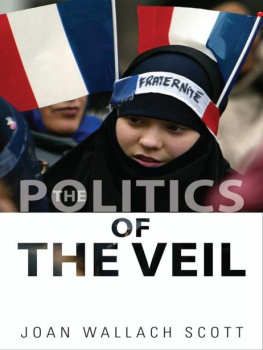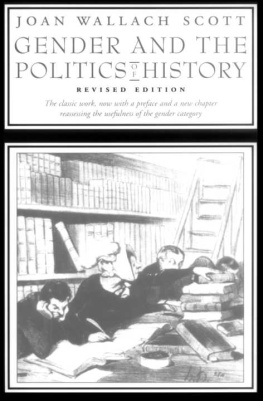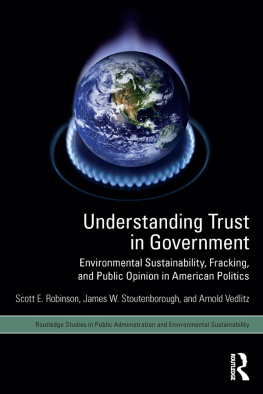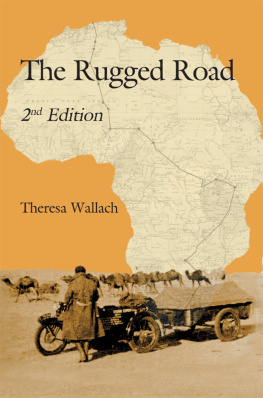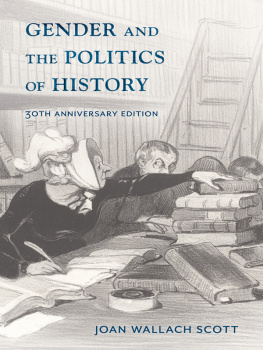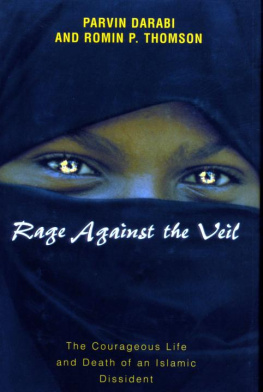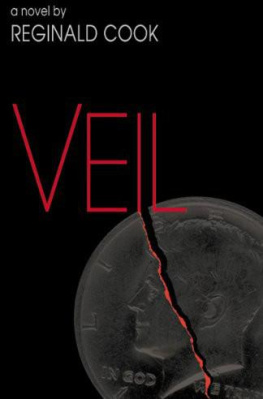Joan Wallach Scott - The Politics of the Veil (The Public Square)
Here you can read online Joan Wallach Scott - The Politics of the Veil (The Public Square) full text of the book (entire story) in english for free. Download pdf and epub, get meaning, cover and reviews about this ebook. year: 2009, publisher: Princeton University Press, genre: Politics. Description of the work, (preface) as well as reviews are available. Best literature library LitArk.com created for fans of good reading and offers a wide selection of genres:
Romance novel
Science fiction
Adventure
Detective
Science
History
Home and family
Prose
Art
Politics
Computer
Non-fiction
Religion
Business
Children
Humor
Choose a favorite category and find really read worthwhile books. Enjoy immersion in the world of imagination, feel the emotions of the characters or learn something new for yourself, make an fascinating discovery.
- Book:The Politics of the Veil (The Public Square)
- Author:
- Publisher:Princeton University Press
- Genre:
- Year:2009
- Rating:4 / 5
- Favourites:Add to favourites
- Your mark:
- 80
- 1
- 2
- 3
- 4
- 5
The Politics of the Veil (The Public Square): summary, description and annotation
We offer to read an annotation, description, summary or preface (depends on what the author of the book "The Politics of the Veil (The Public Square)" wrote himself). If you haven't found the necessary information about the book — write in the comments, we will try to find it.
The Politics of the Veil (The Public Square) — read online for free the complete book (whole text) full work
Below is the text of the book, divided by pages. System saving the place of the last page read, allows you to conveniently read the book "The Politics of the Veil (The Public Square)" online for free, without having to search again every time where you left off. Put a bookmark, and you can go to the page where you finished reading at any time.
Font size:
Interval:
Bookmark:
THE POLITICS OF THE VEIL

THE PUBLIC SQUARE BOOK SERIES
PRINCETON UNIVERSITY PRESS
Ruth OBrien, Series Editor
THE POLITICS OF THE VEIL
Joan Wallach Scott
PRINCETON UNIVERSITY PRESS  Princeton and Oxford
Princeton and Oxford
Copyright 2007 by Princeton University Press
Published by Princeton University Press, 41 William Street,
Princeton, New Jersey 08540
In the United Kingdom: Princeton University Press, 3 Market Place,
Woodstock, Oxfordshire OX20 1SY
All Rights Reserved
LIBRARY OF CONGRESS CATALOGING-IN-PUBLICATION DATA
Scott, Joan Wallach.
The politics of the veil / Joan Wallach Scott.
p. cm.(The public square)
Includes bibliographical references and index.
eISBN: 978-1-40082-789-3
France. 2. IslamophobiaFrance. 3. RacismFrance. 4. Hijab
(Islamic clothing)Law and legislationFrance. 5. MuslimsCultural assimilationFrance. 6. SecularismFrance. 7. Culture conflictFrance. I.Title.
DC34.5.M87S36 2007
305.6'970944dc22 2007013953
British Library Cataloging-in-Publication Data is available
This book has been composed in Adobe Caslon and Helvetica Neue
Printed on acid-free paper.
press.princeton.edu
Printed in the United States of America
1 3 5 7 9 10 8 6 4 2
CONTENTS
FOREWORD
Convening in a churchs basement daycare center, a British Christian group holds a how to workshop on heckling Muslims who lecture in Londons Hyde Park Speakers Corner. After hearing that half the Dutch Muslims dont speak the language, the Parliament of the Netherlands, a country known for centuries of religious and political tolerance, debates whether such individuals should be compelled to take Dutch language classes. And in the German Bundestag, politicians contemplate forbidding imams from preaching in Arabic. But it is in France where public protest and government sanctions against Muslims first took hold.
In her compelling book The Politics of the Veil, Joan Wallach Scott points out that France initiated the discussion in the late 1980s about prohibiting public school girls from wearing headscarves. This discussion culminated in 2004 with such a ban. Two years later, the French government made it illegal to deny that the Turkish killing of Armenians between 1915 and 1917 was genocide.
These sanctions have inflamed rather than eliminated the extremism that led to the commuter-train bombings in Madrid by a Moroccan terrorist cell in 2003; the murder of Dutch filmmaker Theo van Gogh, allegedly by a Dutch-Moroccan Muslim radical in 2004; and the bombs that exploded in London in 2005. Indeed, moderate Muslim groups are beginning to portray Europe as a closed Christian club, and 80 percent of Muslims now feel harassed and discriminated against, a figure that has grown from 35 percent just seven years ago. That many Muslims feel under siege only further fosters an environment ripe for extremism.
Meanwhile, fundamentalist Muslims use these bans to galvanize their own forces. Al-Qaedas number two in command, Ayman Al-Zawahiri, lashed out at those in France who prevent Muslims from covering their heads in schools.When the sanction first took effect, protests broke out on streets from Rabat to Jakarta. In the view of Muslims around the globe, the French law was a deliberate attack on six million of its own residentsthe largest Muslim community in Europe. Later, the riots by French youth, primarily of Algerian and Moroccan colonial descent, expressed widespread feelings of bias, prejudice, and betrayal.
Recognizing that the symbolism of the headscarf ban ignites the anti-immigration Muslim crisis in Europe, the European Union (EU) commissioned a three-year study entitled the VEIL, an acronym for Values, Equality and Differences in Liberal Democracies. It focuses on Austria, Denmark, France, Greece, Germany, Turkey, the Netherlands, and the United Kingdom, and is charged with evaluating the range of anti-discrimination policies and strategies that exist to better integrate minorities, particularly Muslim women, into the European community.
The EU is, however, anything but consistent. In 1998, the European Court of Human Rights upheld Turkeys headscarf ban in public buildings, calling it a victory for Ankaras secularists after a long legal battle. The court in Strasbourg confirmed an earlier ruling that barred a woman from taking a university exam because she wore a headscarf.
The West has long encouraged the secularization of the East. According to Scott, the notion that banning headscarves represents modernization should be challenged. For many in France the fight about secularism is a means (Scott calls it a cover-up) by which the differences between the East and West, Islam and liberal values are accentuated. This is a fight to define the borders of Europe. But, as Scott so convincingly argues, the polemic hides a more complex reality. There is no either/or. The struggle is not between tradition and modernity. Nor is it about presumably universalist values such as the separation of church and state. It is a controversy that reveals the prejudices that white Judeo-Christian Europeans harbor against a portion of their nations denizens, many of whose parents and grandparents came from their former colonies. Laws banning the Islamic headscarf, Scott argues, are fueled by racism, post-colonial guilt and fear, and nationalism.
What is more, the latest policies exacerbate ethnic and religious differences. Most Muslims in France describe themselves first as French and second as practitioners of Islam. Scotts book brings us to the Public Square by showing the effects of laws such as the headscarf prohibition. Islamic nonprofit groups predict the law will simply lead to a boom in private Muslim education, sharpening the very divisions it was intended to fight. The Politics of the Veil starkly reveals the lineaments of the crisis European nations face as they incorporate their immigrant populations, many of them from former colonies, many of them Muslims, into what were once taken to be largely homogeneous societies. Scotts book shows us that this crisis is anything but simple and that there are voices proposing alternate solutions to legal prohibition. This gives us ample room for the kind of debate that should occur in the public square.
RUTH OBRIEN
The CUNY Graduate Center
New York, New York
ACKNOWLEDGMENTS
Without the encouragement of Ruth OBrien and Brigitta van Rheinberg, what began as a lecture would never have turned into a book. I am grateful that they invited me to undertake this project and for their enthusiastic support along the way. Although I had clear opinions about the headscarf ban from the beginning, it took a lot of thought to formulate them; there are sections of the book that I rewrote several times in response to criticism from colleagues and friends. For their objections, advice, and suggestions I would like to thank Talal Asad, Beth Baron, Patrick Chabal, Brian Connolly, Eric Fassin, Kristen Ghodsee, David Scott, Donald Scott, Tony Scott, Farzana Shaikh, Lisa Wedeen, and Elizabeth Weed. Franoise Gaspard and Claude Servan-Schreiber offered many important corrections, as well as clarifications about French history and politics, though I dont think they always shared my point of view. Wendy Brown read the first version of the entire manuscript and forced me to rethink some of its argument. When Saba Mahmood read a later version, her comments prompted yet another revision. The members of the Yale Law Theory Workshop pushed me hard on questions about secularism, as did the members of the Third World Now seminar in the School of Social Science at the Institute for Advanced Study. What appears here is a lot better than those earlier drafts thanks to their interventions.
Next pageFont size:
Interval:
Bookmark:
Similar books «The Politics of the Veil (The Public Square)»
Look at similar books to The Politics of the Veil (The Public Square). We have selected literature similar in name and meaning in the hope of providing readers with more options to find new, interesting, not yet read works.
Discussion, reviews of the book The Politics of the Veil (The Public Square) and just readers' own opinions. Leave your comments, write what you think about the work, its meaning or the main characters. Specify what exactly you liked and what you didn't like, and why you think so.

